
There is an assumption that when the Money Supply falls, the economy will go into a recession. This is true in a simplistic way. This simplistic statement leads to utterly incorrect thought processes leading to dire consequences. There is one layer of logic missing. It is utterly incorrect to assume that increasing the Money Supply will revitalise and economy. When a Money Supply falls, it is a fall in the Circulating Money component of the Money Supply that causes the economy to enter a recession. Hoarded Money tends to stay hoarded. This is confirmed when the velocity falls. On entry to a recession, there is a fall in the money that is actually acting as money which I measure as Circulating Money.
When the Money Supply falls, money tends to be removed from the real economy rather than from Hoarded Money. Those with ‘more money than they can spend’ tend not to spend and tend to retain their money. A fall in the velocity of money will also cause a recession, but it is less likely to occur. Any study of recessions needs to monitor the Circulating Money as this is the real key to the understanding of recession economics.
Circulating Money is changing hands regularly and is easier to syphon. Most tax is taken from Circulating Money. Interest and loan repayments tend to be taken from Circulating Money. This graph for Canada shows the effect particularly well. Canada had a small fall in the M3 Money Supply (1.6% green inset) but a dramatic fall in the Circulating Money (8% light blue). In time, I shall draw some more graphs.

In the graph above, a Money Supply fall of 1.6% caused a Circulating Money fall of about 8%. [2] The next graph shows that the Cash Currency issued by the central bank on behalf of the government did not fall:

The effect is dramatic in a different way in the USA. The next graph shows a fall in Circulating Money for U.S.A. at about the 2008 mark.

The USA fall matches the hiccup in the Money Supply in the following graph:
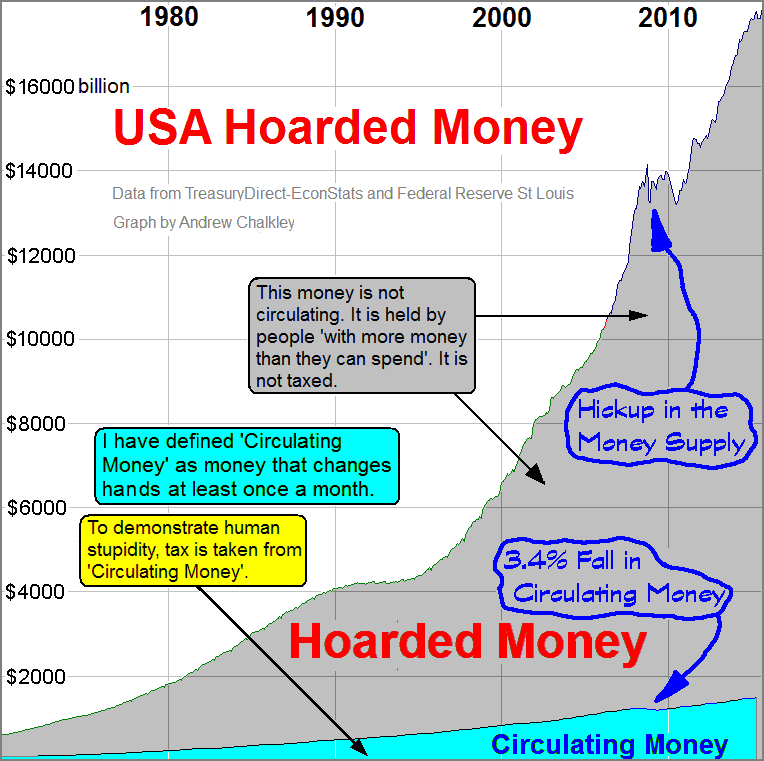
For completeness, have a look at the velocity during this time. Money pushed into the economy did not boost Circulating Money. The hoarders got their hands on it. Neither did hoarders release Hoarded Money.
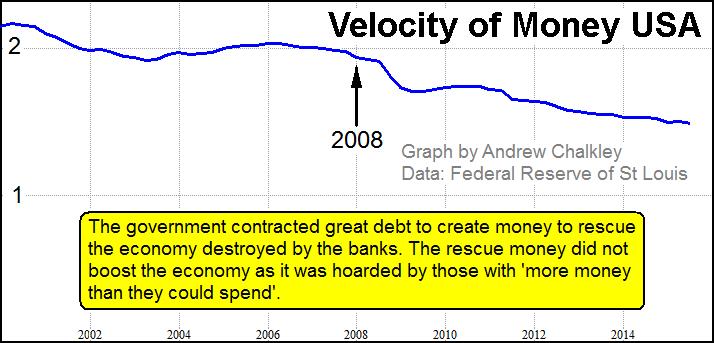
In this following graph, you can see a huge cutback in the lending of banks to the private sector. Interest and repayments continue to be collected. This potentially causes a big fall in the Money Supply. However, a large increase in government borrowing maintains the Money Supply.

The next diagram represents a velocity of two which corresponds to a Hoarded Money rate of 83%. Almost all taxation and almost all interest are taken from Circulating Money:
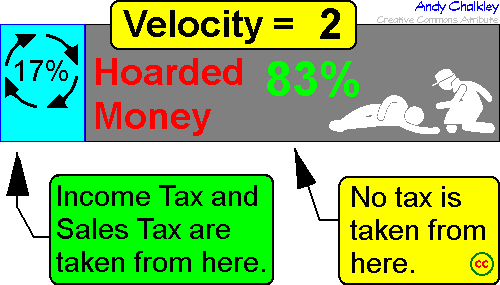
The next diagram shows the influence of removing interest from the economy. Almost all interest is taken from Circulating Money:
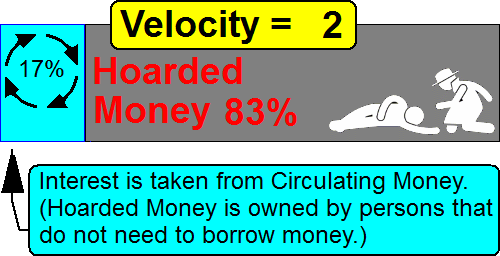
In the next diagram, I shall reduce the Money Supply by about 9%. This is remarkably easy to do as we hammer the hell out of Circulating Money and worship Hoarded Money. The quickest way to reduce the quantity of Circulating Money thrashing through the microeconomic veins of the nation is for the banks to cease money creation whilst ripping repayments and interest from Circulating Money. The banks pull this stunt on a regular basis. Vast quantities of money are removed from Circulating Money each year, which in most years is replaced by fresh loans. Whenever the banks decide to stop lending or the citizens decide to cease borrowing the Circulating Money falls and a recession is created. Our society and the controllers of our politicians have completely overlooked the crucial role that private banks play as creators of the Money Supply and the total disregard these banks display towards the maintenance of the Money Supply. This also makes it difficult to predict the onset of a recession. It is not easy to predict the behaviour of banks and their lending practices. This graph shows me reducing the Money Supply by 9%. Interest is taken from circulating money and so it is circulating money that falls. Thus a minor fall in the Money Supply can create a massive fall in the circulating money.

The 9% fall in the Money Supply caused a 50% fall in Circulating Money which equates to a 50% fall in business activity. So I present the Canada graph again to demonstrate that very small falls in the Money Supply create drastic reductions in Circulating Money. The effect is far more pronounced in nations with low velocity.

A consideration of Circulating Money reveals that businesses simply pass money through their hands and do not decrease Circulating Money. Since the days when revolutions removed the practice where sovereigns created the debt-free money of the nation, governments remove tax from Circulating Money but spend it straight back into circulation, thus not affecting the volume of Circulating Money. When governments borrow money through bond issues, they are borrowing existing money, which is quite likely to be Hoarded Money. This may increase Circulating Money. The only strong influence over Circulating Money is tied into the lending habits of banks. If loans exceed repayments and interest, the Circulating Money increases. If the sum of repayments and interest exceeds fresh loans, Circulating Money falls. Hoarded Money tends not to be affected because hoarders do not need to borrow as they already have ‘more money than they can spend’.
Although it is correct that a fall in the Money Supply will cause the economy to go into recession, it is utterly incorrect to assume that the opposite is true. There is a missing stage of the logic. When the Money Supply falls, it is usually the Circulating Money that falls. Circulating Money is easier to remove from the economy than hibernating money. However, when the Money Supply is increased, the fresh money is more likely to become Hoarded Money. It tends to go to those who have ‘more than they can spend’ causing an increase in Hoarded Money rather than an increase in Circulating Money. The procedure needed to increase the Circulating Money is quite tricky. Circulating Money is, by its very nature, moving from transaction to transaction, which means it is partaking in business transactions. To increase Circulating Money is not just a matter of throwing money into the money pool, it is the rate of business transactions that needs to be increased. If business has been burnt, with businesses going to the wall and factories closing their doors, it is going to be difficult to persuade the business fraternity to crank up business simply by throwing money at them or making credit available. The best approach is to avoid a fall in Circulating Money in the first place. This is the subject of a later chapter.
So what will cause the Money Supply to fall? In the last chapter, I demonstrated that the government has no ability to cause a change in the Money Supply even though it is common practice to blame the government. The government collects tax and spends the tax. Any minor shortfall is borrowed from the existing Money Supply through the mechanism of bond issue and immediately spent back into society. There is no change to the magnitude of the Money Supply through any government tax collection or expenditure.
Banks, on the other hand, can and do alter the Money Supply. The banks make loans on a daily basis. Banks collect principal and interest repayments on a daily basis. If the loans are being issued at a faster rate than loans are collected, the Money Supply increases. If loans are recalled at a faster rate than loans are issued, the Money Supply falls. Repayments and interest are collected from people that do not have excess money and so are collected from Circulating Money. Thus a very small fall in the Money Supply has a devastating effect on the economy. In this diagram, an 8% fall in the Money Supply has the potential to reduce the Circulating Money by 50%. In practice, it is a bit less, but you can see the potential for economic drama with just a small fall in the Money Supply.

Now let us have a careful look at a series of graphs for the 2008 crisis. Take a long time working through this graph. Particularly notice the fall in the Money Supply and its relation to the fall in Private Debt. Private Debt falls as fresh loans are not created. However, loan repayments and interest continue to be collected. The result is a fall in the Money Supply. The fall in the Money Supply is removed from the Circulating Money. This damages the GDP. The government tried to rectify the 2008 situation by taking on debt itself in a clever obfuscation called ‘Quantitative Easing’. I’ll explain Quantitative Easing in a later chapter. There is some fascinating logic behind it and it would take a genius to design and execute the process. It nearly worked, but the hoarders got hold of the money. The essence was that the fed bought existing bonds, which released freshly-created virtual dollars into the Money Supply. The fed created the fresh bank-credit to purchase existing and perhaps new bonds [a ratio I have yet to determine]. This certainly puts new bank credit into the Money Supply, but you can detect a fall in velocity, which indicates that the money fell into the hands of those with ‘more money than they can spend’. My thinking is that the bonds were purchased from institutions who had no need of money. The better solution would be to ensure money got to persons with little money who would spend it immediately into circulation and into the hands of small business owners. You can download the graph from the website. The result of the ‘Quantitative Easing’ increase in the Money Supply was that the increase largely finished up in the hands of those with ‘more money than they can spend’ and thus became hoarded. A full understanding of the process is only possible by considering Circulating Money. It took three years before I could compile the following graph. I doubt that you will understand it at the first attempt.

In this graph of the Great Depression, you can see that the government-issued cash-currency did not fall. The banks cut their lending whilst continuing to collect interest and loan repayments.
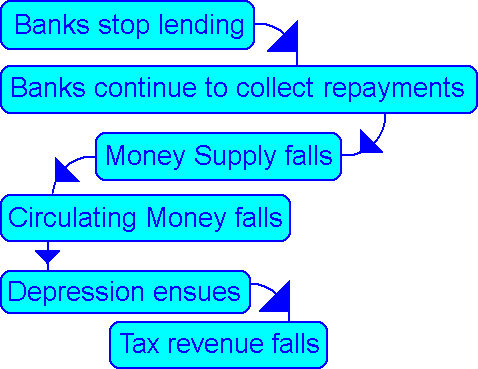
This is a classic bank-induced recession/depression. ![]() Banks stop lending.
Banks stop lending. ![]() Banks continue to collect interest and repayments.
Banks continue to collect interest and repayments. ![]() Money supply falls.
Money supply falls. ![]() Depression ensues.
Depression ensues.
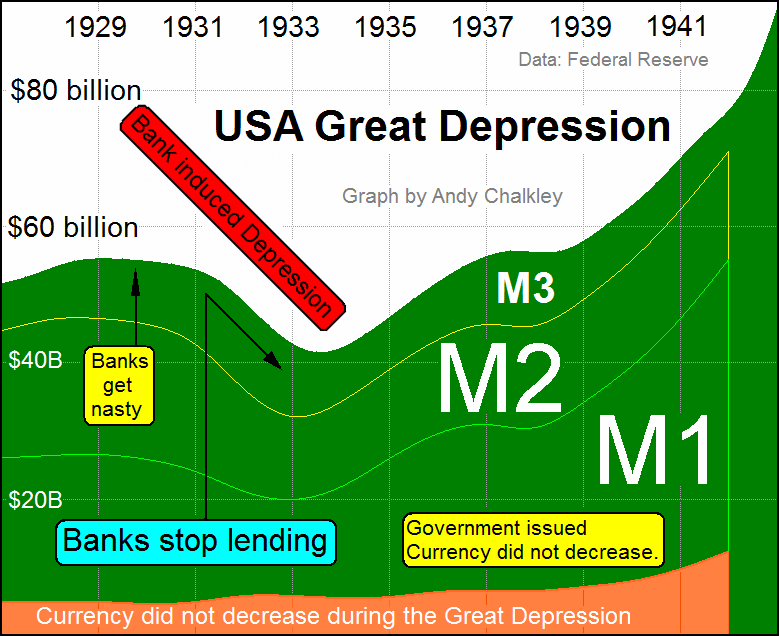
Notice that the Bank Credit portion of the Money Supply decreases whilst the government issued cash currency increases slightly. This is caused by bank lending practices causing a fall in Bank Credit. The media will suggest that it is poor government management. The cessation of lending could be for a number of reasons which could be malicious or unintended.
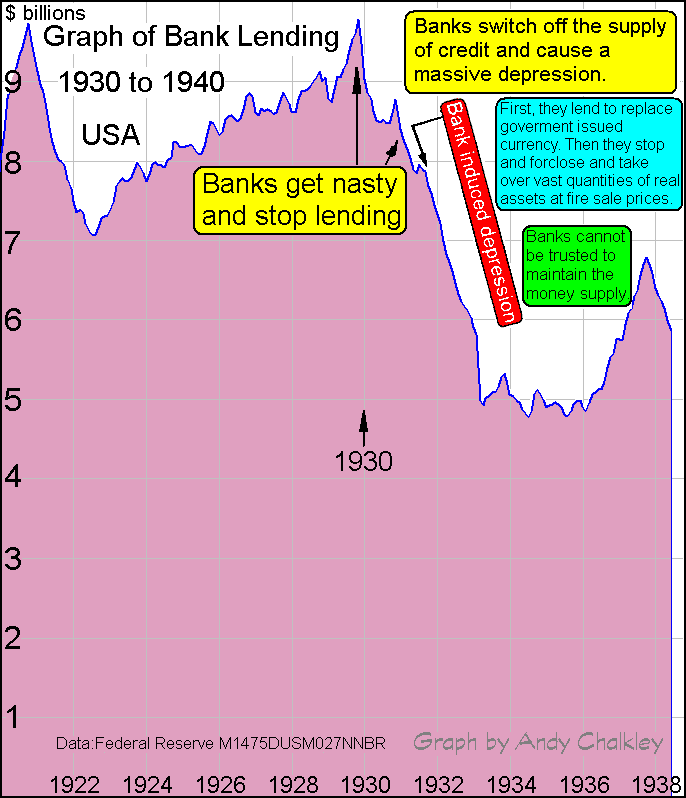
Next, I give you a graph of Circulating Money during the Great Depression:

You can see similar for Greece. The Government issued cash currency does not fall. The banks stop lending. Banks continue to collect interest and repayments. The Money Supply falls draining Circulating Money. The situation is made worse when the creditors demand austerity which is counterproductive to economic recovery. No-one seems to realise that it costs nothing to create money and that it is governments that have the authority to create the money of the nation. You can see that Greece is the only country to repay significant debt. Total repayment is, of course, impossible as the debt exceeds the volume of money. No country can repay its debt unless it sets up its own public bank. No one asks the obvious question: Where did the IMF get the €30 billion that it lent to Greece? It did not come from the ECB. It was an account entry. It did not exist before it was lent to Greece:
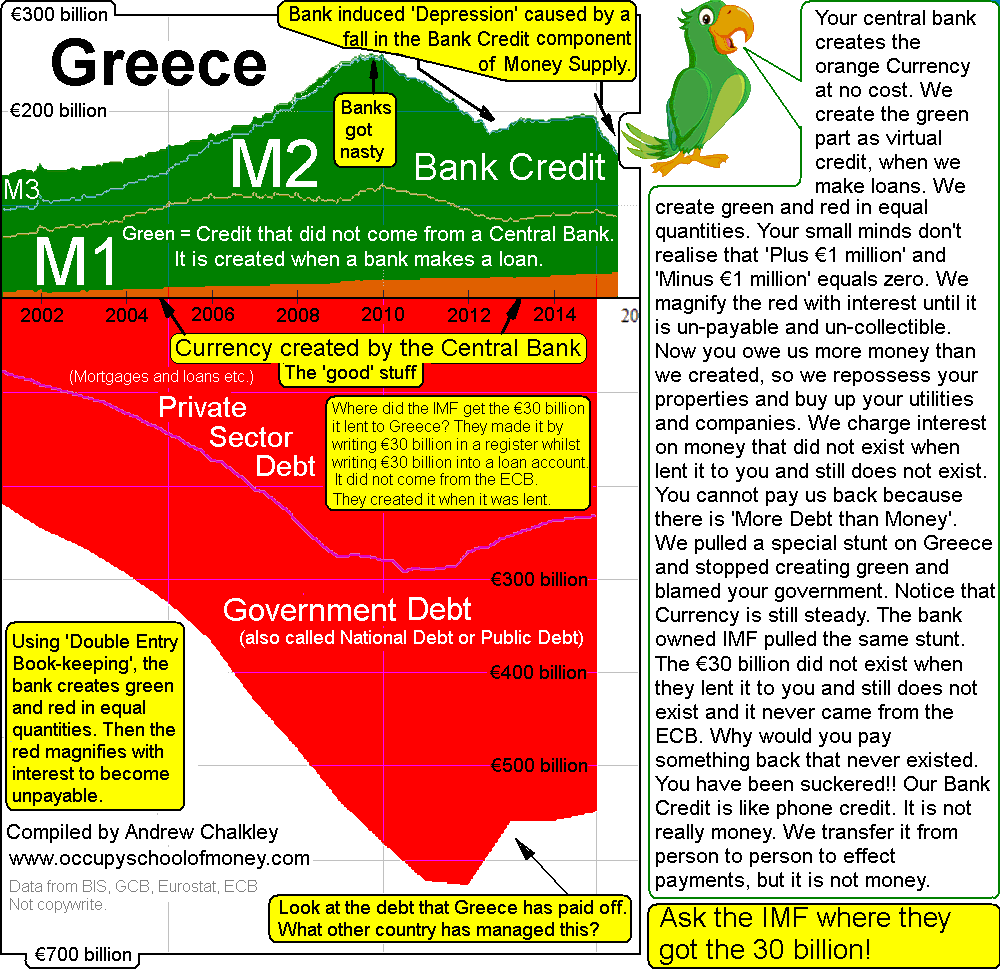
You may find Spain interesting:

So, all you need to do to destroy an economy is to reduce the Money Supply which dramatically reduces the Circulating Money. The only way to reduce the Money Supply is to arrange for the banks to cut back on lending whilst continuing to collect interest and repayments. In past times the situation was different. Before the various revolutions in Europe, the sovereign of a nation created the money of the nation and spent it into society, effectively operating a debt free society. Gone are the days when sovereign governments created the money of the nation in a debt-free manner and spent it into society.
The king would operate the money system and create the legal tender of the nation. The king would spend money into society and then tax money back out in similar quantities. Taxation had the effect of creating a demand for the money and preventing oversupply. Society operated in a debt-free manner. There was plentiful money in society without the need to borrow. Correctly operated, money was plentiful enough to be earned and interest was payable to no-one. Debt basically did not exist. There was no national debt because the king and his government created money on an as needs basis and spent it into society. Most taxes that we currently know did not exist. Management of the Money Supply was a matter of spending sufficient into society and taxing money back out of circulation. Modification of the Money Supply occurred by altering the rate of the sovereign’s spending and the rate of taxation. This system also had problems and was not well understood. Sovereigns would spend at to their whim and hopefully, it was spent on efficiency assets for the nation such as bridges, roads, schools, parks, and ports. Sometimes, money creation was decentralised with local mints in large towns. Sovereigns often enabled local mints to issue coinage on an as needs basis from precious metal. The King would delegate churches and archbishops the responsibility of creating currency in the larger population centres. You will notice the magnificent cathedrals in Great Britain that appear to correspond to the location of the local church mints. The church did get exceedingly rich during this time, but much of the money was spent back into society. Magnificent cathedrals were built, but the church also ran many of the functions of the local society now done by armies of bureaucrats in offices.
Henry the First, son of William the Conqueror, set up debt-free-money with the tally stick in 1100 AD. This system lasted seven hundred years. Tally sticks were spent into society and taxed back out of society. Even though tally sticks were intrinsically worthless, taxation created a demand for them. England had no National-Debt. National-Debt arrived with the privately owned Bank of England. (National-Debt is by definition money owed to private organisations.) The creation of the tally stick took money out of the hands of the money changers and thus stopped the practice of usury. King Henry had created the tally stick system to counter the influence of private goldsmiths and moneychangers who were wreaking economic havoc by manipulating the supply of gold coins. [1]
England had this very effective money system that lasted eight hundred years where the king spent into society and taxed the same back out of circulation. The Tally Stick system was designed to avoid corruption by money lenders. This system successfully curtailed the influence of debt for centuries. This changed with the civil war in England, the dictatorship of Cromwell, and the 1688 installation of William of Orange as King of England by the pro-Venetian English oligarchy. Shortly after the installation of William of Orange from Holland, the ‘new’ concept of ‘National Debt’ arrived when a small syndicate of private business entrepreneurs created the Bank of England and lent money to the king. The freshly installed king acquiesced to the wishes of the money lenders and ceased money creation as a sovereign. From that time money was borrowed into existence. The government allowed the interest-free tally stick money system to be replaced debt based money issued by a Private Banking Corporation inappropriately called the ‘Bank of England’. The Bank did not belong to England, but to a group of private individuals. The government foolishly paid interest to the Private Bank of England on the issued money at 6% each three months. A taxation system being set-up for the purpose of collecting money to be given to the owners of the bank. [James Stuart]. From that time, money is borrowed into existence. This had some interesting consequences. Debt has made people work hard and has caused unprecedented progress in our modern society with unprecedented environmental damage.
There are movements trying to institute debt free money systems, often called sovereign money systems where the government creates the money of the nation and spends the money into society. Taxation then removes excess money to prevent oversupply and inflation. Presently we have to learn to deal with a debt based system. Back to the topic of the chapter:
In this current money system, the government cannot reduce the Money Supply because it only collects tax and spends the proceeds. When it borrows by issuing bonds, it is borrowing pre-existing bank credit. Government-created cash currency only forms about 5% of the Money Supply. [UK 3%, Australia 3.5%, USA 7%.] The government, itself, does not use cash currency in its transactions, it uses bank credit in bank accounts. The government has no control whatsoever over the magnitude of the Money Supply. The government effectively operates as any other large business. It taxes to obtain revenue and spends the same money straight back into society. Any shortfall is covered by borrowing through a complex system of issuing bonds. The issue of bonds does not affect the magnitude of the Money Supply as the government borrows pre-existing bank credit. Bonds are issued and payment is by credit of a government account with pre-existing bank credit, allowing the government to pay for services to society. The issuing of bonds may, however, alter the composition of the Money Supply by moving Hoarded Money into circulation. Bonds will be purchased by those with ‘more money than they can spend’ and so there is the likelihood that Hoarded Money may purchase bonds which the government then spends into circulation.
The major cause of recessions occurs when banks cut back on lending. The banks collect interest and repayments but seriously cut back on lending, causing a fall in the Money Supply. The reasons for a cutback in lending may be various and may be malicious or unintended. High levels of debt tend to discourage consumer and business borrowing and put a restraint on consumer spending and business expansion. The areas of the economy that the banks lend into also affect the economy. If banks are reluctant to lend to business, business will suffer. If banks lend for land and house speculation, house prices will rise as will rents and business costs. However, the primary cause of recessions is a fall in bank lending.

There are only limited actions that the government can take as the government has no way to force banks to issue fresh money and no way of forcing the generated bank money into business. One solution is for the government to create a public bank and counter the destructive cyclical nature of bank lending by partaking in what is commonly called ‘counter-cyclical finance’. This involves the government bank creating loans for public development at exactly the time that the private banking industry decides to restrict lending. Another action is to take business-friendly actions to encourage business. This will include regulatory changes and taxation changes. Particularly hurtful to business expansion is the method to depreciate purchased assets. Although little recognised, depreciation is a delay in tax deductions for assets purchased by expanding businesses. Another hurtful tax is Payroll Tax which favours those with unearned income which tends to be those that have ‘more money than they can spend’ and are the hoarders of money. Sales Tax is hurtful to business and should be reduced or simply delayed. I have yet to create a graphical demonstration of the negative effects of Sales Tax, but it is definitely counter-productive to a vibrant economy. I can produce graphs that demonstrate that income tax reduction can lift business activity to the extent that it lifts tax revenue.

The graph is somewhat controversial. I don’t wish to use the graph as a proof, but rather a demonstration that my logic has some merit.
All governments need taxation to exist. It is not a matter of whether tax is to be collected, but how it is collected so as to do minimal harm to the welfare of the people. Where tax is taken inappropriately, the gap between rich and poor can increase. If the tax is not carefully crafted, the entire economy may be slowed. In some cases, the tax may even become revenue negative such that an increase in tax rate will cause a reduction in government revenue. Some taxation methods may be so difficult to enforce that an army of taxation officers are necessary to enforce compliance. The taxation authority may become like a second police force. In general, it is better to leave the money in the hands of the working people for they spend it quickly which keeps the Circulating Money flowing.
Taxation tends to be taken from the Circulating Money giving a constant negative influence on Circulating Money. Although tax is seen as a negative, the government spends the taxed money back into society. Those with ‘more money than they can spend’ will tend to discourage tax on their money hoardings and accumulated assets with the result that almost no tax will be taken from Hoarded Money in the form of Land Tax, Rates, Demurrage Tax, Wealth Tax, Financial Transactions Tax, Death Tax and Inheritance Tax. Unearned income is taxed at a lower rate than earned income due to Payroll Tax and assisted by an army of clever accountants finding procedures that are not available to the wage earner. Bank lending often tends to favour investors rather than small business. Small business will suffer from the lack of available credit whilst land prices will be inflated by excessive lending for real estate speculation. This pushes up business costs and drives business to countries that do not have ‘usury of land’. Regulations unfavourable to business will also damage the economy.